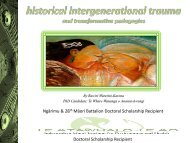Determination of EDTA in Dairy Wastewater and Adjacent Surface ...
Determination of EDTA in Dairy Wastewater and Adjacent Surface ...
Determination of EDTA in Dairy Wastewater and Adjacent Surface ...
You also want an ePaper? Increase the reach of your titles
YUMPU automatically turns print PDFs into web optimized ePapers that Google loves.
PROCEEDINGS OF WORLD ACADEMY OF SCIENCE, ENGINEERING AND TECHNOLOGY VOLUME 34 OCTOBER 2008 ISSN 2070-3740<br />
<strong>Determ<strong>in</strong>ation</strong> <strong>of</strong> <strong>EDTA</strong> <strong>in</strong> <strong>Dairy</strong> <strong>Wastewater</strong> <strong>and</strong><br />
<strong>Adjacent</strong> <strong>Surface</strong> Water<br />
Congm<strong>in</strong> Z. Xie, Terry Healy, Peter Rob<strong>in</strong>son, <strong>and</strong> Kev<strong>in</strong> Stewart<br />
Abstract—An HPLC-UV analytical method was developed to<br />
determ<strong>in</strong>e ethylenediam<strong>in</strong>etetraacetic acid (<strong>EDTA</strong>) <strong>in</strong> dairy<br />
wastewater <strong>and</strong> surface water. The optimiz<strong>in</strong>g separation was achieved<br />
by reversed–phase ion-pair liquid chromatography on a C18 column<br />
us<strong>in</strong>g methanol as mobile phase solvent, tetrabutylammonium bromide<br />
as the ion-pair reagent <strong>in</strong> pH 3.3 formate buffer solution at a flow rate<br />
<strong>of</strong> 0.9 mL m<strong>in</strong> -1 with a UV detector at 265 nm. No <strong>in</strong>terference <strong>of</strong> Ca,<br />
Mg or NO 3 - was detected. Method performance was evaluated <strong>in</strong> terms<br />
<strong>of</strong> l<strong>in</strong>earity, repeatability <strong>and</strong> reproducibility. The method detection<br />
limit was 5 µg L -1 . The contents <strong>of</strong> <strong>EDTA</strong> <strong>in</strong> dairy effluents were 72 ~<br />
261 µg L -1 at a large dairy site. A change <strong>of</strong> <strong>EDTA</strong> concentration was<br />
observed downstream <strong>of</strong> the dairy effluent discharge, but this was well<br />
under the predicted no effect concentration for aquatic ecosystem.<br />
Keywords—<strong>Dairy</strong> wastewater, <strong>EDTA</strong>, HPLC, surface water.<br />
I. INTRODUCTION<br />
LEANING <strong>of</strong> equipment for production plants is a key<br />
C process <strong>in</strong> the dairy <strong>in</strong>dustry to ensure safe products with<br />
high quality. It has been demonstrated [1] that us<strong>in</strong>g synergic<br />
effects <strong>of</strong> s<strong>in</strong>gle components <strong>in</strong> chemical mixtures, for <strong>in</strong>stance<br />
add<strong>in</strong>g an effective complex<strong>in</strong>g agent, is more likely to achieve<br />
an improved cleans<strong>in</strong>g result with lower concentration<br />
compared to aqueous solutions merely conta<strong>in</strong><strong>in</strong>g the basic<br />
component <strong>of</strong> sodium hydroxide. The ma<strong>in</strong> function <strong>of</strong><br />
complex<strong>in</strong>g agents <strong>in</strong> a clean<strong>in</strong>g solution is to prevent<br />
precipitation <strong>of</strong> calcium, magnesium <strong>and</strong> heavy metal salts,<br />
which can cause deposits to appear on both the clean<strong>in</strong>g<br />
equipment <strong>and</strong> the plant to be cleaned [2].<br />
At present, ethylenediam<strong>in</strong>etetraacetic acid (<strong>EDTA</strong>) is the<br />
cheapest <strong>and</strong> most suitable complex<strong>in</strong>g compound for many<br />
technical purposes, <strong>and</strong> is used <strong>in</strong> large quantities [3]. In the<br />
New Zeal<strong>and</strong> dairy <strong>in</strong>dustry, <strong>EDTA</strong> has been used as a clean<strong>in</strong>g<br />
additive to improve the cleans<strong>in</strong>g efficiency dur<strong>in</strong>g the<br />
clean–<strong>in</strong>–place (CIP) procedure.<br />
Nearly all applications eventually result <strong>in</strong> the release <strong>of</strong><br />
<strong>EDTA</strong> to the aquatic environment [2], [3]. In the late 1980s, the<br />
environmental impacts <strong>of</strong> <strong>EDTA</strong> were scrut<strong>in</strong>ized <strong>in</strong> Europe, as<br />
<strong>EDTA</strong> occurred at a higher concentration <strong>in</strong> surface waters than<br />
any other identified anthropogenic organic compounds that may<br />
C. Z. Xie <strong>and</strong> T. Healy are with the University <strong>of</strong> Waikato, Hamilton 3240,<br />
New Zeal<strong>and</strong> (correspond<strong>in</strong>g author, phone: 0064-7-8562889 Ext. 7223; fax:<br />
0064-7-8585200; e-mail: cx3@ Waikato.ac.nz).<br />
P. Rob<strong>in</strong>son is with Hill Laboratories, 1 Clyde St. Private 3205, Hamilton<br />
3240, NZ (e-mail: Peter.Rob<strong>in</strong>son@hill-labs.co.nz).<br />
K. Stewart is with the Waikato Institute <strong>of</strong> Technology (W<strong>in</strong>tec), Private Bag<br />
3036, Hamilton 3240, NZ (e-mail: kev<strong>in</strong>.stewart@w<strong>in</strong>tec.ac.nz).<br />
cause further environmental issues [3]-[5]. In New Zeal<strong>and</strong>,<br />
dairy effluent is commonly discharged <strong>in</strong>to the adjacent surface<br />
water. However, there is concern about large volumes <strong>of</strong><br />
wastewater with a high <strong>EDTA</strong> content discharged <strong>in</strong>to<br />
relatively small rivers [3], [4].<br />
The commonly used methodology for <strong>EDTA</strong> determ<strong>in</strong>ation<br />
<strong>in</strong> samples <strong>of</strong> different matrices is based upon complex<strong>in</strong>g with<br />
iron (III) as an analyte that is the most stable complex<br />
compound (pKa = 25), employ<strong>in</strong>g UV as a detect<strong>in</strong>g method<br />
[6]-[12].<br />
In the present study, a method us<strong>in</strong>g an isocratic HPLC<br />
system, a C18 reversed-phase (RP) column <strong>and</strong> UV detector has<br />
been developed. The chromatographic separation was<br />
optimized by compositions <strong>of</strong> the mobile phase <strong>and</strong> flow rate.<br />
The <strong>in</strong>terfer<strong>in</strong>g compounds <strong>of</strong> calcium/magnesium <strong>and</strong> nitrates<br />
at levels occurr<strong>in</strong>g <strong>in</strong> dairy waste waters were <strong>in</strong>vestigated, <strong>and</strong><br />
the accuracy <strong>and</strong> precision <strong>of</strong> the method were determ<strong>in</strong>ed. The<br />
applicability <strong>of</strong> this method was demonstrated by analyz<strong>in</strong>g<br />
dairy wastewater <strong>and</strong> surface water samples. Analyzed results<br />
demonstrated levels <strong>of</strong> <strong>EDTA</strong> <strong>in</strong> dairy effluents from a large<br />
dairy site. Contents <strong>of</strong> <strong>EDTA</strong> <strong>in</strong> the adjacent river showed the<br />
change <strong>of</strong> <strong>EDTA</strong> concentrations due to the dairy effluent<br />
discharge.<br />
II. EXPERIMENTAL<br />
Apparatus<br />
The HPLC system consisted <strong>of</strong> a Shimadzu LC – 10 AT VP<br />
Liquid Chromatography (USA) with a 50 µL sample loop, a<br />
Shimadzu SPD – 10A VP UV - Vis detector set at 265 nm, a<br />
Hypersil C 18 RP column (Phenomenex) <strong>of</strong> length 200 mm,<br />
diameter 4.6 mm <strong>and</strong> particle size 5µm, <strong>and</strong> a Phenomenex<br />
security guard column. The HPLC record<strong>in</strong>g <strong>and</strong> <strong>in</strong>tegration<br />
s<strong>of</strong>tware was PowerChrom (eDAQ Pty Ltd, Australia) attached<br />
to a Powerlab/8sp data recorder (ADInstrument). All water was<br />
obta<strong>in</strong>ed from an ELGAS TAT ® UHQII system <strong>and</strong> filtered<br />
through 0.45µm Nylon filters (Phenomenex). Degass<strong>in</strong>g <strong>of</strong> the<br />
mobile phase was achieved by pass<strong>in</strong>g helium sparg<strong>in</strong>g.<br />
Reagents, Chemicals <strong>and</strong> Solutions<br />
Reagents were all chromatographic analysis grade or reagent<br />
grade used without further purification. A sodium formate /<br />
formic acid buffer solution (pH 3.3) was prepared by dissolv<strong>in</strong>g<br />
0.17g sodium formate (BDH) <strong>and</strong> 0.33 ml (Ajax F<strong>in</strong>chem) 90%<br />
formic acid <strong>in</strong> 1 L <strong>of</strong> water. An ion-pair reagent solution (15<br />
mM TBABr) was prepared by dissolv<strong>in</strong>g 4.836g <strong>of</strong><br />
tetra-n-butylammoniumbromide (C 16 H 36 NBr, 322.38 g mol -1 )<br />
PWASET VOLUME 34 OCTOBER 2008 ISSN 2070-3740 50 © 2008 WASET.ORG
PROCEEDINGS OF WORLD ACADEMY OF SCIENCE, ENGINEERING AND TECHNOLOGY VOLUME 34 OCTOBER 2008 ISSN 2070-3740<br />
(Merck) <strong>in</strong> 1L <strong>of</strong> pH = 3.3 buffer solution. A stock <strong>EDTA</strong><br />
st<strong>and</strong>ard solution (0.1 g L -1 <strong>EDTA</strong>) was prepared by dissolv<strong>in</strong>g<br />
0.1462 g ethylenediam<strong>in</strong>etetraacetic acid iron sodium salt (MW<br />
= 421.10 g mol -1 ) (Merck) <strong>in</strong> 1L <strong>of</strong> water, <strong>and</strong> stored <strong>in</strong> the<br />
refrigerator wrapped <strong>in</strong> t<strong>in</strong> foil. St<strong>and</strong>ard solutions, rang<strong>in</strong>g<br />
from 0–750 µg L -1 <strong>EDTA</strong> for calibration, were prepared daily<br />
from the stock solution. A Fe 3+ solution (0.1941g L -1 or 3.47<br />
mM) was prepared by dissolv<strong>in</strong>g 2.4203 g FeCl 3· 6H 2 O<br />
(Merck) <strong>and</strong> 0.144mL HCl (37% Merck) <strong>in</strong> 500 mL water. A<br />
nitrate solution (1 g L -1 ) was prepared by dissolv<strong>in</strong>g 0.4077 g <strong>of</strong><br />
KNO3 (Seelze–Hannover) <strong>in</strong> 250 mL water as a stock solution<br />
for further dilution. Calcium (0.1 g L -1 ) <strong>and</strong> magnesium (0.1 g<br />
L -1 ) ion solutions were prepared by dissolv<strong>in</strong>g 0.2732g <strong>of</strong><br />
CaCl2· 6H2O (BDH) <strong>and</strong> 0.1046 g <strong>of</strong> MgCl 2· 6H 2 O (BDH) <strong>in</strong><br />
500 mL water respectively for further dilution.<br />
Sample Collection<br />
<strong>Dairy</strong> wastewaters were 24–hour composite<br />
flow-proportional samples <strong>in</strong>clud<strong>in</strong>g plant process<strong>in</strong>g<br />
wastewater, wastewater treatment process<strong>in</strong>g sample <strong>and</strong> dairy<br />
effluents, which were collected at varied sites <strong>in</strong> August,<br />
October <strong>and</strong> December, 2007.<br />
<strong>Surface</strong> water samples were collected at 2500 m (site 1) <strong>and</strong><br />
10 m (site 2) upstream <strong>and</strong> 10 m (site 3) <strong>and</strong> 60 m (site 4)<br />
downstream <strong>of</strong> dairy effluent discharges <strong>in</strong> the adjacent river <strong>in</strong><br />
August, October, 2007. Sampl<strong>in</strong>g sites are shown <strong>in</strong> Fig. 1. The<br />
river was approximately 6-8 m wide <strong>and</strong> 1-2 m deep. <strong>Surface</strong><br />
water samples <strong>in</strong>cluded a morn<strong>in</strong>g <strong>and</strong> an afternoon sample<br />
which were comb<strong>in</strong>ed by two different samples from the<br />
morn<strong>in</strong>g <strong>and</strong> afternoon, respectively.<br />
All samples were collected <strong>in</strong> opaque PE bottles to avoid<br />
photolysis <strong>of</strong> the Fe(III)<strong>EDTA</strong> <strong>and</strong> refrigerated at 4 0 C till<br />
analyz<strong>in</strong>g.<br />
Stream 2<br />
River flow<br />
Stream 1<br />
Fig 1 Sampl<strong>in</strong>g sites <strong>of</strong> surface waters upstream <strong>and</strong> downstream <strong>of</strong> the<br />
dairy effluent discharge<br />
Sample Pre-Treatment<br />
Sample pre-treatment <strong>of</strong> dairy effluents <strong>in</strong>volved tak<strong>in</strong>g 1–5<br />
mL aliquots, add<strong>in</strong>g appropriate Fe 3+ solution to the test tube<br />
depend<strong>in</strong>g the predicted <strong>EDTA</strong> concentration, leav<strong>in</strong>g<br />
overnight <strong>in</strong> the dark to allow complex<strong>in</strong>g <strong>of</strong> Fe(III)<strong>EDTA</strong>,<br />
filter<strong>in</strong>g through 0.45 µm cellulose nitrate filters<br />
(Phenomenex), <strong>and</strong> <strong>in</strong>ject<strong>in</strong>g 50 µL sample <strong>in</strong>to the HPLC<br />
system at ambient temperature.<br />
Sample pre-treatment <strong>of</strong> surface water <strong>in</strong>volved heat<strong>in</strong>g 10<br />
mL water sample to dryness at 90 0 C oven, add<strong>in</strong>g 1.5 mL<br />
mobile phase <strong>and</strong> 0.5 mL 1.94 mg L -1 Fe 3+ solution, leav<strong>in</strong>g<br />
overnight <strong>in</strong> dark to complex, filter<strong>in</strong>g <strong>and</strong> <strong>in</strong>ject<strong>in</strong>g 50 µL <strong>of</strong><br />
sample <strong>in</strong>to the HPLC system. This gave a five-fold<br />
pre-concentration <strong>of</strong> the <strong>EDTA</strong> before analyses.<br />
III. RESULTS AND DISCUSSION<br />
A. Optimiz<strong>in</strong>g Chromatographic Separations<br />
A number <strong>of</strong> HPLC methods have been published to<br />
determ<strong>in</strong>ate <strong>EDTA</strong> <strong>in</strong> multi-media samples [6]-[12]. A review<br />
<strong>of</strong> the literature <strong>in</strong>dicated that the method <strong>of</strong> Loyaux-Lawniczak<br />
et al. [7] seemed the most appropriate. This method was<br />
published as suitable for natural waters.<br />
The aim <strong>of</strong> HPLC separations <strong>in</strong> our case was to ensure that<br />
the analytical component <strong>of</strong> [Fe(III)<strong>EDTA</strong>] - completely<br />
separated from other compounds <strong>in</strong> dairy wastewater samples,<br />
with a practical separation time <strong>of</strong> less than 10 m<strong>in</strong>utes, <strong>and</strong> to<br />
ensure that other metal – <strong>EDTA</strong> complexes were totally<br />
converted <strong>in</strong>to [Fe(III)<strong>EDTA</strong>] - before analyses. The method<br />
was thus optimized for a dairy wastewater matrix, <strong>in</strong>clud<strong>in</strong>g<br />
check<strong>in</strong>g possible <strong>in</strong>terferences at levels found <strong>in</strong> dairy waste<br />
waters. A different pre-treatment was also found to be needed.<br />
In select<strong>in</strong>g a particular buffer, the buffer capacity <strong>and</strong> its UV<br />
absorbance must be taken <strong>in</strong>to account. Buffer capacity is<br />
determ<strong>in</strong>ed by pH, buffer pKa <strong>and</strong> buffer concentration. The<br />
buffer range <strong>of</strong> k-formate / formic acid is 2.8 – 4.8 <strong>and</strong> the UV<br />
cut<strong>of</strong>f is 210 nm (10 mM) (absorbance < 0.5) [13]. The pH<br />
value <strong>of</strong> 3.3 was chosen as 99.2% <strong>of</strong> Fe(III)<strong>EDTA</strong> exists <strong>in</strong> its<br />
deprotonated form [7]. Furthermore, there is no absorbance at<br />
the wavelength <strong>of</strong> 265 nm [13].<br />
In reversed phase (RP) separations, the sample retention can<br />
be controlled by vary<strong>in</strong>g the solvent strength <strong>of</strong> a mobile phase.<br />
This can be achieved either by us<strong>in</strong>g different solvents or<br />
vary<strong>in</strong>g the percent organic (% B) composition with the same<br />
solvent <strong>in</strong> the mobile phase. Both acetonitrile (ACN) [6], [8]<br />
<strong>and</strong> methanol (MeOH) [7], [10], [12] were <strong>in</strong>vestigated as<br />
solvents. A similar retention time was achieved us<strong>in</strong>g a lower<br />
percentage <strong>of</strong> ACN (1%) than MeOH (5%) if other parameters<br />
rema<strong>in</strong>ed the same. The study <strong>of</strong> different % B compositions <strong>of</strong><br />
MeOH showed that <strong>in</strong>creas<strong>in</strong>g % MeOH shortened the<br />
retention time. Buffer solution with 2% MeOH was selected for<br />
giv<strong>in</strong>g a practical retention time <strong>and</strong> a good separation<br />
(2
PROCEEDINGS OF WORLD ACADEMY OF SCIENCE, ENGINEERING AND TECHNOLOGY VOLUME 34 OCTOBER 2008 ISSN 2070-3740<br />
Fig. 2 Effect <strong>of</strong> concentration <strong>of</strong> TBABr on retention <strong>of</strong> Fe(III)<strong>EDTA</strong><br />
Retention time <strong>in</strong>creases with a lower flow rate, but the<br />
separation <strong>of</strong>ten improves (Fig. 3). The flow rate was set at 0.9<br />
mL m<strong>in</strong> -1 for a better separation with a practical analysis time.<br />
Fig. 3 Effect <strong>of</strong> flow rate <strong>of</strong> mobile phase on retention <strong>of</strong> Fe(III)<strong>EDTA</strong><br />
The HPLC separation for Fe(III)<strong>EDTA</strong> <strong>of</strong> <strong>in</strong>terest <strong>in</strong> the<br />
dairy waste water is shown <strong>in</strong> Fig. 4 by vary<strong>in</strong>g solvent<br />
strengths <strong>and</strong> ion-pair reagent TBABr concentrations with the<br />
optimized flow rate (0.9 mL m<strong>in</strong> -1 ). The optimal solvent<br />
strength <strong>and</strong> concentration <strong>of</strong> TBABr were 2% methanol <strong>and</strong><br />
15mM TBABr for a best resolution, respectively.<br />
a. 5 % MeOH, 10 mM TBABr, κ '> 2<br />
b. 2 % MeOH, 15 mM TBABr, κ' > 2<br />
c. 5 % MeOH, 15 mM TBABr, κ '< 2<br />
concentration <strong>of</strong> NO 3<br />
-<br />
[7], [11].<br />
The concentration <strong>of</strong> nitrate <strong>in</strong> dairy waste waters varies<br />
depend<strong>in</strong>g upon the process. Levels <strong>of</strong> nitrate found <strong>in</strong> dairy<br />
wastewater were below 100 mg L -1 . An experiment was<br />
undertaken by add<strong>in</strong>g different concentrations <strong>of</strong> NO 3<br />
-<br />
(10, 50<br />
<strong>and</strong> 100 mg L -1 ) to a 100 µg L -1 <strong>EDTA</strong> st<strong>and</strong>ard solution. There<br />
seemed to be no <strong>in</strong>terference to the Fe(III) <strong>EDTA</strong> peak.<br />
Nowack et al. [8] stated that waters with high calcium <strong>and</strong><br />
magnesium ions may <strong>in</strong>fluence the determ<strong>in</strong>ation <strong>of</strong> <strong>EDTA</strong> due<br />
to the matrix effect. The content <strong>of</strong> calcium <strong>in</strong> dairy effluent<br />
was significantly <strong>in</strong>creased compar<strong>in</strong>g with local clean water (8<br />
~ 10 times) at a large dairy site studied. To <strong>in</strong>vestigate this<br />
<strong>in</strong>terference, an experiment was carried out by spik<strong>in</strong>g a 100µg<br />
L -1 <strong>EDTA</strong> st<strong>and</strong>ard solution with different concentrations (10,<br />
25, 50 <strong>and</strong> 100 mg L -1 ) <strong>of</strong> Ca 2+ <strong>and</strong> Mg 2+ respectively. The<br />
effect <strong>of</strong> the mixture <strong>of</strong> Ca 2+ <strong>and</strong> Mg 2+ (4:1) was also studied.<br />
The overall results showed no significant <strong>in</strong>terference <strong>of</strong> these<br />
metals on the HPLC determ<strong>in</strong>ation <strong>of</strong> <strong>EDTA</strong>.<br />
In dairy waste waters, <strong>EDTA</strong> exists ma<strong>in</strong>ly <strong>in</strong> the form <strong>of</strong><br />
Ca<strong>EDTA</strong> <strong>and</strong> Mg<strong>EDTA</strong>. These species have low pKa value <strong>and</strong><br />
slow exchange k<strong>in</strong>etics [8]. Pre-treatment is thus needed to<br />
convert these species to Fe(III)<strong>EDTA</strong> for the analysis <strong>of</strong> total<br />
<strong>EDTA</strong> <strong>in</strong> a sample. A series <strong>of</strong> experiments were carried out<br />
which <strong>in</strong>volved add<strong>in</strong>g different levels (C <strong>EDTA</strong> : C Fe3+ =1:0.194)<br />
<strong>of</strong> excess Fe 3+ (1x Fe 3+ , 1.5 x Fe 3+ , 2 x Fe 3+ , 5 x Fe 3+ , 10 x Fe 3+<br />
<strong>and</strong> 20 x Fe 3+ ) to a 100 µg L -1 <strong>EDTA</strong> st<strong>and</strong>ard solution under<br />
different pre-treatment conditions. The procedure <strong>in</strong>volved:<br />
• Heat<strong>in</strong>g <strong>in</strong> 90 o C water bath for over 3 hours [7], [8];<br />
• Plac<strong>in</strong>g <strong>in</strong> a dark place over night [12]; <strong>and</strong><br />
• Boil<strong>in</strong>g for 1.5 hours.<br />
The experimental results revealed that (i) the addition <strong>of</strong><br />
excess Fe 3+ levels appeared not to affect the determ<strong>in</strong>ation <strong>of</strong><br />
<strong>EDTA</strong> (peak areas) except by disturb<strong>in</strong>g the basel<strong>in</strong>e <strong>and</strong><br />
shift<strong>in</strong>g the peak retention time <strong>of</strong> the chromatogram at higher<br />
concentration <strong>of</strong> iron (Fig. 5); <strong>and</strong> (ii) similar results were<br />
obta<strong>in</strong>ed with different pre-treatment conditions. Consequently,<br />
the overnight pre-treatment was applied for subsequent<br />
experiments.<br />
mv<br />
a<br />
<strong>EDTA</strong><br />
a. 100 ug/L <strong>EDTA</strong> std. + 1 x Fe3+<br />
b. 100 ug/L <strong>EDTA</strong> std. only<br />
c. 100 ug/L <strong>EDTA</strong> Std. + 2 x Fe3+<br />
d. 100 ug/L <strong>EDTA</strong> std. + 20 x Fe3+<br />
<strong>EDTA</strong> peak<br />
a<br />
b<br />
<strong>EDTA</strong><br />
mv<br />
b<br />
c<br />
<strong>EDTA</strong><br />
mv<br />
c<br />
d<br />
M<strong>in</strong>.<br />
Fig. 4 Opitimazation <strong>of</strong> chromatographic separation <strong>of</strong> dairy<br />
wastewaers<br />
M<strong>in</strong>.<br />
B. Interfer<strong>in</strong>g Compounds<br />
In general, waste waters from dairy process<strong>in</strong>g plants<br />
conta<strong>in</strong>s high concentrations <strong>of</strong> organic material <strong>and</strong> <strong>in</strong>organic<br />
compounds such as NO - 3 , Ca 2+ <strong>and</strong> Mg 2+ with large variations <strong>in</strong><br />
pH. Organic substances do not generally <strong>in</strong>terfere with the<br />
determ<strong>in</strong>ation <strong>of</strong> <strong>EDTA</strong>. However, the determ<strong>in</strong>ation <strong>of</strong> <strong>EDTA</strong><br />
could be under-estimated <strong>in</strong> the presence <strong>of</strong> a high<br />
Fig. 5 Overlay <strong>of</strong> chromatograms by add<strong>in</strong>g different levels <strong>of</strong> iron to a<br />
100 µg L -1 <strong>EDTA</strong> st<strong>and</strong>ard solution. Conditions: Column, Hypersil<br />
C 18 RP column (Phenomenex) <strong>of</strong> length 200 mm, diameter 4.6 mm <strong>and</strong><br />
particle size 5 µm; Mobile phase, 2% MeOH, 15 mM TBABr <strong>in</strong> pH 3.3<br />
sodium formate/formic acid buffer solution; sample loop, 50 µL; Flow<br />
rate, 0.9 mL m<strong>in</strong> -1 ; Wavelength, 265 nm<br />
M<strong>in</strong>.<br />
PWASET VOLUME 34 OCTOBER 2008 ISSN 2070-3740 52 © 2008 WASET.ORG
PROCEEDINGS OF WORLD ACADEMY OF SCIENCE, ENGINEERING AND TECHNOLOGY VOLUME 34 OCTOBER 2008 ISSN 2070-3740<br />
C. Method Accuracy, Precision <strong>and</strong> Detection Limit<br />
There is no Certificated Reference Material (CRM) available<br />
for <strong>EDTA</strong> <strong>in</strong> waters. The method accuracy was checked us<strong>in</strong>g<br />
the analyte spike recovery, which 100 µg L -1 <strong>of</strong> <strong>EDTA</strong> was<br />
added dairy wastewater samples. The spike recoveries were<br />
between 98 % <strong>and</strong> 102 % (n = 9). Calibration curve<br />
(concentration versus peak area) was obta<strong>in</strong>ed with <strong>EDTA</strong><br />
concentrations rang<strong>in</strong>g from 0 to 750 µg L -1 (0, 10, 50, 100,<br />
200, 500 <strong>and</strong> 750 µg L -1 ) <strong>of</strong> a st<strong>and</strong>ard solution for dairy<br />
wastewater, which were prepared daily from the stock solution<br />
<strong>of</strong> 0.1 g L -1 <strong>of</strong> <strong>EDTA</strong>. Good l<strong>in</strong>earity <strong>and</strong> reproducibility were<br />
observed dur<strong>in</strong>g the experiment. Precision <strong>of</strong> the method was<br />
determ<strong>in</strong>ed by analyz<strong>in</strong>g each sample 12 times (Table I). The<br />
repeatability given as the relative st<strong>and</strong>ard deviation was less<br />
than 1.5 %. The method detection limit (MDL) was calculated<br />
on three times the st<strong>and</strong>ard deviation <strong>of</strong> sample 1 (3*1.43 µg/L),<br />
giv<strong>in</strong>g 5 µg/L <strong>EDTA</strong>.<br />
TABLE I<br />
METHOD REPEATABILITY TEST RESULTS FROM REPLICATE DAIRY<br />
WASTEWATER ANALYSES<br />
Tests<br />
Sample 1<br />
(µgL -1 )<br />
Sample 2<br />
(µgL -1 )<br />
1 107.2 1792.4<br />
2 107.9 1759.3<br />
3 107.1 1758.9<br />
4 107.7 1780.3<br />
5 107.5 1756.3<br />
6 106.9 1737.5<br />
7 106.2 1801.1<br />
8 106.9 1751.0<br />
9 107.7 1753.6<br />
10 104.7 1765.7<br />
11 107.0 1766.8<br />
12 103.0 1759.3<br />
Average 106.7 1765.2<br />
STDEV 1.43 17.97<br />
% RSD 1.34 1.01<br />
D. <strong>EDTA</strong> Analyses <strong>in</strong> <strong>Dairy</strong> Waste Waters<br />
Around 80 dairy waste waters were analyzed, <strong>in</strong>clud<strong>in</strong>g<br />
wastewater from the process<strong>in</strong>g plants, wastewater dur<strong>in</strong>g the<br />
wastewater treatment process<strong>in</strong>g <strong>and</strong> dairy effluent discharg<strong>in</strong>g<br />
<strong>in</strong>to the adjacent river. The concentrations <strong>of</strong> <strong>EDTA</strong> varied<br />
from 72 µg L -1 to 82.7 mg L -1 . A typical chromatogram <strong>of</strong> dairy<br />
waste water is shown <strong>in</strong> Fig. 6. The range <strong>of</strong> <strong>EDTA</strong><br />
concentration (72 ~ 261 µg L -1 ) <strong>of</strong> dairy effluents discharged<br />
<strong>in</strong>to the adjacent river is shown <strong>in</strong> Fig. 7. Data was from 3 days<br />
<strong>in</strong> August, 3 days <strong>in</strong> October <strong>and</strong> 7 days <strong>in</strong> December 2007.<br />
Samples were all 24–hour composite.<br />
Peak height (mv)<br />
<strong>EDTA</strong> peak<br />
Retention time (m<strong>in</strong>)<br />
Fig. 6 Typical chromatogram <strong>of</strong> a dairy wastewater sample<br />
<strong>EDTA</strong> concentration (µg L -1 )<br />
<strong>EDTA</strong> peak<br />
Samples<br />
Fig. 7 Concentrations <strong>of</strong> <strong>EDTA</strong> <strong>in</strong> dairy effluents discharged <strong>in</strong>to<br />
the adjacent river from a large dairy site<br />
E. <strong>Determ<strong>in</strong>ation</strong> <strong>of</strong> <strong>EDTA</strong> <strong>in</strong> <strong>Surface</strong> Water<br />
Forty eight surface water samples, collected <strong>in</strong> August <strong>and</strong><br />
October 2007, were analyzed by the described HPLC method.<br />
A typical chromatogram <strong>of</strong> the surface water sample is shown<br />
<strong>in</strong> Fig. 8. The calibration curve was established daily at the<br />
concentration <strong>of</strong> 0 to 150 µg L -1 (0, 10, 20, 50, 80, 100 <strong>and</strong> 150<br />
µg L -1 ). Duplicate analyses were undertaken every 10 samples<br />
<strong>and</strong> the spike recoveries <strong>of</strong> surface water (50 µg L -1 <strong>EDTA</strong><br />
st<strong>and</strong>ards) every 20 samples as a quality control dur<strong>in</strong>g the<br />
experiment. Averaged duplicate variability was 8.1 % (n=5)<br />
<strong>and</strong> spike recovery varied from 97 – 107% (n=3). The averaged<br />
<strong>EDTA</strong> concentrations, with one st<strong>and</strong>ard deviation, upstream<br />
<strong>and</strong> downstream <strong>of</strong> the dairy effluent discharge are shown <strong>in</strong><br />
Fig. 9. This data represents averaged 12 results at each site. It<br />
can be seen from Fig. 9 that concentrations <strong>of</strong> <strong>EDTA</strong> were<br />
<strong>in</strong>creased downstream 60 m <strong>of</strong> the effluent discharge before the<br />
other stream jo<strong>in</strong>s <strong>in</strong>. The change <strong>of</strong> <strong>EDTA</strong> contents was not<br />
obvious at 10 m downstream as <strong>EDTA</strong> may not be mixed well<br />
with river water yet. The highest concentration <strong>of</strong> <strong>EDTA</strong><br />
analyzed at 60 m downstream was 2.7 µg L -1 . This was well<br />
under the predicted no effect concentration for aquatic<br />
environment – 2.2 mg L -1 [3].<br />
PWASET VOLUME 34 OCTOBER 2008 ISSN 2070-3740 53 © 2008 WASET.ORG
PROCEEDINGS OF WORLD ACADEMY OF SCIENCE, ENGINEERING AND TECHNOLOGY VOLUME 34 OCTOBER 2008 ISSN 2070-3740<br />
Retention time (m<strong>in</strong>)<br />
Fig. 8 Typical chromatogram <strong>of</strong> a surface water sample with 1.7 µg L -1<br />
<strong>of</strong> <strong>EDTA</strong><br />
<strong>EDTA</strong> Con. (µg L -1 )<br />
Peak height (mv)<br />
Fe(III)<strong>EDTA</strong><br />
Fe(III)<strong>EDTA</strong><br />
[3] European Union, “Tetrasodium Ethylenediam<strong>in</strong>eacetate(Na 4 <strong>EDTA</strong>),<br />
European Union Risk Assessment Report, ” E. C. Bureau, 2004<br />
[4] Biogeochemistry <strong>of</strong> Chelat<strong>in</strong>g Agents, Vol. ACS910, B. Nowack <strong>and</strong> J. M.<br />
VanBriesen, Eds. Oxford University Press, Wash<strong>in</strong>gton D.C., 2005, p.458<br />
[5] M. Bucheli-Witschel <strong>and</strong> T. Egli, “Environmental fate <strong>and</strong> microbial<br />
degradation <strong>of</strong> am<strong>in</strong>opolycarboxlic acids,” FEM Microbiology Review<br />
Vol. 25, pp. 69-106, 2001<br />
[6] C. E. Cagnasso, L. B. Lόpez, V. G. Rodríguez <strong>and</strong> M. E. Valencia,<br />
“Development <strong>and</strong> validation <strong>of</strong> a method for the determ<strong>in</strong>ation <strong>of</strong> <strong>EDTA</strong><br />
<strong>in</strong> non-alcoholic dr<strong>in</strong>ks by HPLC,” Journal <strong>of</strong> Food Composition <strong>and</strong><br />
Analysis, Vol. 20, pp. 248-25, 2007<br />
[7] S. Loyaux-Lawniczak, J. Douch <strong>and</strong> P. Behra, “Optimisation <strong>of</strong> the<br />
analytical detection <strong>of</strong> <strong>EDTA</strong> by HPLC <strong>in</strong> natural waters”, Fresenius J<br />
Anal Chem, Vol. 364, pp.727-731,1999<br />
[8] B. Nowack, F. G. Kauri, S. U. Hilger, <strong>and</strong> L. Sigg, “<strong>Determ<strong>in</strong>ation</strong> <strong>of</strong><br />
dissolved <strong>and</strong> adsorbed <strong>EDTA</strong> species <strong>in</strong> water <strong>and</strong> sediments by HPLC,”<br />
Anal Chem, Vol. 68, pp. 561-566,1996<br />
[9] P. M. Nirel, P. E. Pardo, C. L<strong>and</strong>ry <strong>and</strong> R. Revalier, “ Method for <strong>EDTA</strong><br />
speciation determ<strong>in</strong>ation : application to sewage treatment plant<br />
effluents,” Water Res, Vol.32, pp. 3615-3620, 1998<br />
[10] P. La<strong>in</strong>e <strong>and</strong> R. Matil<strong>in</strong>en, “Simultaneous determ<strong>in</strong>ation <strong>of</strong> DTPA, <strong>EDTA</strong>,<br />
<strong>and</strong> NTA by UV-visible spectrometry <strong>and</strong> HPLC,” Anal Bioanal Chem,<br />
Vol. 382, pp.1601-1609, 2005<br />
[11] Germany st<strong>and</strong>ard methods DIN 38413 – 8, 2000<br />
[12] L. Katata, V. Nagaraju <strong>and</strong> A. M. Crouch, “<strong>Determ<strong>in</strong>ation</strong> <strong>of</strong><br />
ethylenediam<strong>in</strong>etetraacetic acid, ethylenediam<strong>in</strong>edisucc<strong>in</strong>ic acid <strong>and</strong><br />
im<strong>in</strong>odisucc<strong>in</strong>ic acid <strong>in</strong> cosmetic products by capillary electrophoresis <strong>and</strong><br />
high performance liquid chromatography,” Analytica Chimica Acta, Vol.<br />
579, pp. 177-184, 2006<br />
[13] L. R. Snyder, J. J. Kirkl<strong>and</strong> <strong>and</strong> J. L. Glajch, Practical HPLC method<br />
Development,2 nd Ed, A Wiley-Interscience publication, JOHN WILLEY<br />
& SONS, INC, 1997<br />
Sampl<strong>in</strong>g sites<br />
Fig. 9 <strong>EDTA</strong> concentrations upstream <strong>and</strong> downstream <strong>of</strong> dairy<br />
effluent discharge <strong>in</strong> the adjacent surface water<br />
IV. CONCLUSION<br />
An HPLC-UV analytical method was described to determ<strong>in</strong>e<br />
<strong>EDTA</strong> as Fe(III)<strong>EDTA</strong> us<strong>in</strong>g UV detection. The<br />
chromatography separation was optimized by adjust<strong>in</strong>g<br />
compositions <strong>of</strong> the mobile phase <strong>and</strong> flow rate on a C18<br />
reversed-phase column. The possible <strong>in</strong>terferences <strong>of</strong> nitrate,<br />
calcium <strong>and</strong> magnesium from dairy waste waters were<br />
<strong>in</strong>vestigated <strong>and</strong> no <strong>in</strong>terference found. <strong>Dairy</strong> waste waters with<br />
vary<strong>in</strong>g <strong>EDTA</strong> levels between µg L -1 to mg L -1 were analyzed<br />
with an acceptable repeatability (duplicate) <strong>and</strong> reproducibility<br />
(spike recovery). The method detection limit was 5 µg L -1 .<br />
The method was applied to determ<strong>in</strong>e <strong>EDTA</strong> <strong>in</strong> the adjacent<br />
surface water <strong>in</strong>to which large amounts dairy effluents (7,000<br />
m 3 ) were discharged. A contribution <strong>of</strong> <strong>EDTA</strong> from the dairy<br />
effluent was observed at 60 m downstream before the other<br />
stream jo<strong>in</strong>ed <strong>in</strong>, but not 10 m downstream <strong>of</strong> the discharge.<br />
Overall <strong>EDTA</strong> concentrations <strong>in</strong> the adjacent surface water<br />
were less than 3 µg L -1 . This was well under the predicted no<br />
effect concentration for aquatic ecosystem.<br />
REFERENCES<br />
[1] G. Bylund, “Clean<strong>in</strong>g <strong>of</strong> dairy equipment,” <strong>in</strong> <strong>Dairy</strong> Process H<strong>and</strong>book;<br />
Lund, Sweden: Tetra Pak Process<strong>in</strong>g Systems AB, 1995, pp. 403-413<br />
[2] K. Wolf <strong>and</strong> P. A. Gilbert, “<strong>EDTA</strong>-Ethylenediam<strong>in</strong>etetraacetic Acid,” <strong>in</strong><br />
The H<strong>and</strong>book <strong>of</strong> Environmental Chemistry, Vol. 3, O. Hutz<strong>in</strong>ger, Ed.<br />
Spr<strong>in</strong>ger-Verlag Berl<strong>in</strong> Heidelberg, 1992, pp. 243- 259<br />
PWASET VOLUME 34 OCTOBER 2008 ISSN 2070-3740 54 © 2008 WASET.ORG

















